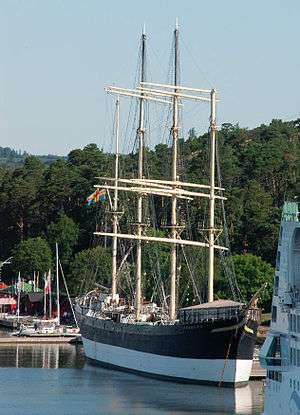Pommern (ship)
Pommern, formerly Mneme (1903–1908), is an iron-hulled sailing ship. It is a four-masted barque that was built in 1903 in Glasgow, Scotland at the J. Reid & Co shipyard.
 Pommern at Mariehamn, Finland in 2005 | |
| History | |
|---|---|
| Name: |
|
| Owner: |
|
| Builder: | J Reid & Co |
| Launched: | 1903 |
| Status: | Museum ship |
| General characteristics | |
| Type: | Iron-hulled sailing ship |
| Tonnage: | |
| Length: | 95 m (311 ft 8 in) |
| Beam: | 13 m (42 ft 8 in) |
| Draught: | 7.5 m (24 ft 7 in) |
| Propulsion: | Sails, 3,420 m2 (36,800 sq ft) |
| Sail plan: | Barque |
| Complement: | 26 |
Pommern (German for Pomerania) is one of the Flying P-Liners, the famous sailing ships of the German shipping company F. Laeisz. In 1921 the Pommern had to be handed over to Greece as war reparation. In 1923 she was acquired by Gustaf Erikson of Mariehamn in the Finnish Åland archipelago, who used her to carry grain from the Spencer Gulf area in Australia to harbours in England or Ireland until the start of World War II.
On 2 March 1925, Pommern ran aground at Port Germein, South Australia,[1] but she was refloated and returned to service.
After World War II, Pommern was donated to the town of Mariehamn as a museum ship. It is now a museum ship belonging to the Åland Maritime Museum and is anchored in western Mariehamn, Åland. A collection of photographs taken by Ordinary Seaman Peter Karney in 1933 showing dramatic pictures of life on a sailing ship rounding Cape Horn can be found in the National Maritime Museum at Greenwich.
A 1:35-scale model of Pommern hangs in Grundtvigs Kirke, in Copenhagen, Denmark, though on being donated to the church in 1939, the model was renamed Dronning Alexandrine in honour of Denmark's then- queen consort.[2]
Pommern is so-called "bald-headed barque": it does not have royals over her upper topgallant sails. The topsails and topgallant sails have been divided in two (upper and lower) to ease their handling.
Pommern has the reputation of being a "lucky ship". She survived both world wars unscathed, lost only four crew members at sea on her journeys, and won the Great Grain Races twice, 1930 and 1937. "Pommern" is thus one of the most popular landmarks of Åland, and is visited by thousands of visitors annually.
In 2019 Pommern was placed in a purpose-built dock facility that can be pumped dry for periodic maintenance of the ship's hull.
Technical details
- Structure: Built of steel
- Sail plan: 4 masted barque
- Length: 95 m (312 ft)
- Width: 13 m (43 ft)
- Draft: 7.5 m (25 ft)
- Gross register tonnage: 2376
- Net register tonnage: 2114
- Cargo: 4,050 t (3,990 long tons; 4,460 short tons)
- Height of main mast: 50 m (160 ft)
- Total area of sails: 3,240 m2 (34,900 sq ft)
- Area of square sails: 2,450 m2 (26,400 sq ft)
- Crew: 26
References
- "Casualty Reports". The Times (47003). London. 4 March 1935. col A, p. 26.
- Grundtvigs Kirke [Grundtvig's Church] (in Danish), København, DK
Further reading
- Kåhre, Georg (1978). The Last Tall Ships: Gustav Erikson and the Åland Sailing Fleets 1872–1947. Greenwich: Conway Maritime Press. ISBN 0-85177-134-3